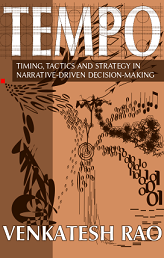
In Mr. Turner (2014), Mike Leigh’s lambent portrait of the artist as an old man, the protagonist sits for a daguerreotype. Behind the camera is an American prosopon, whose primordial photographs are advertised to “stand the test of time and climate.” Intentionally or otherwise, the scene establishes a passing of the torch between light-wranglers. It also anticipates the appearance of Turner’s unnatural successor, the American James Abbott MacNeill Whistler, whose technique a sitter once described as developing “a negative under the action of […] chemicals.”
Whistler would not set foot in London until 1859, eight years after Turner’s death but, when he did, the groundwork would be more or less prepared for a career agonist. A cosmopolitan whose scope extended from the US to Russia through Chile, Whistler would systematically be [at] the centre of the world, at a time when European art was barely postindustrial. Wagner may have held court at Bayreuth, but Whistler forged, and bridged, the early modern transatlantic artworld.
He refashioned his biography and cultivated his persona into something he could set loose against critics and patrons, carving costly inroads into the contractual and public perceptual domains. Though his victory against Ruskin earned him no more than a farthing, bankruptcy and a Venetian exile, it wasn’t Pyrrhic by any epochal measure. (The same cannot, alas, be said for Whistler’s frenemy, Oscar Wilde, whose libel suit proved nothing short of suicidal.) With the Royal Academy and its satellite salons still in the game of academicism and its malcontents, he became adept at solo showmanship. As with his private exhibitions, his Peacock Room was not decor but installation.

Whistler’s portraits pack terroir and not just atmosphere. The best example of this is Arrangement in Grey and Black No.1, the famous painting of his mother. No print can do it justice. At a nearly square 144.3 cm x 162.4 cm and mounted on a frame of the artist’s own design, it is in every way heroic. (It’s hardly a coincidence that Thomas Carlyle would become the subject of Arrangement…No. 2.). Though touted as some manner of hieratic icon, the mother of a younger god is but an older goddess, no less static than a crocodile. Behold, the Baudelairian giantess in/action.
Early in his career, Whistler shared a mistress with Gustave Courbet: Joanna Hiffernan, she of The Origin of the World. Here she is again, revised, revisited, as her antithesis, in chambered and exploratory greyscale.





The Louvre relegates The Painter’s Mother to a Staircase
Article is long on adjectives and recursive adjectival clauses. Suggest sprinkling some plain-language declarative sentences in amongst the others for contrast.
Very interesting set of connections coming off this.
Whistler’s paintings seem an interesting example of failed resistance to signification that his rooms achieve far better; reading up on this, he supposedly was interested in the patterns of colour and light and texture produced by certain kinds of composition, but unlike later abstract artists, where pure composition and texture was all there was, forcing observers to engage with his work on an immediate level (or, to be more creative in their extractions) here he still worked within the basic assumptions of portraiture, interior design, and landscape, but with a focus on what we would probably now call aesthetic.
Whereas now people make aesthetic blogs that push forward a specific experiential context, when whistler’s work was exhibited by others, this sense was obscured, with a structure of enframing it was unable to wordlessly refuse.
To me, his interior decoration more immediately represents that aesthetic sense, overwhelming it’s function, even if trying to take material control of the means of enframing didn’t work out terribly well for him in the end.